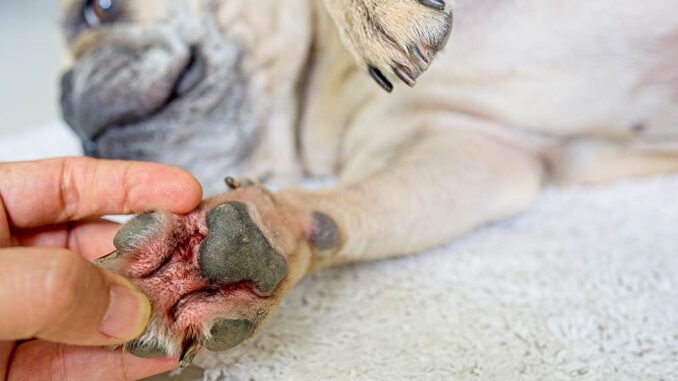
This article was updated on August 6th, 2023
Managing fungal infections on your dog’s paws can be a difficult endeavor. As a practicing veterinarian, I’ve seen first-hand how stubborn these fungal infections can be. Early recognition of symptoms and swift action is essential to prevent complications.
In this article I’ll teach owners how to identify fungal infections in your dog’s paws, how you might be able to manage them at home and how to recognize when veterinary intervention is necessary.
The goal however, is not only treating existing fungal infections but also preventing them from recurring in the future by maintaining a healthy dog’s coat and body condition – I’ll provide some helpful insights into how to do this.
Symptoms of Fungal Infections in Dog Paws
Fungi thrive in warm, moist environments, making your dog’s paws one of the most common areas that can develop a fungal infection. Common signs include:
- Itchy paws & licking or chewing at feet excessively
- Brownish-red discoloration between toes and paw pads
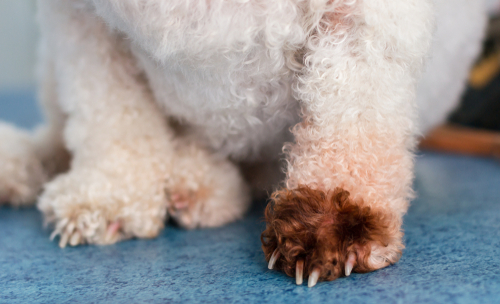
- Foul odor coming from the paws
- Crusty skin
- Hair loss on and around the infected area, as shown on the picture below:
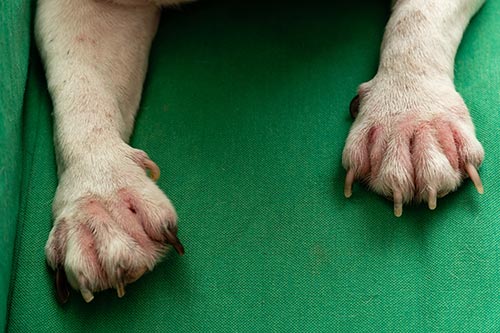
- Inflammation, redness, swelling
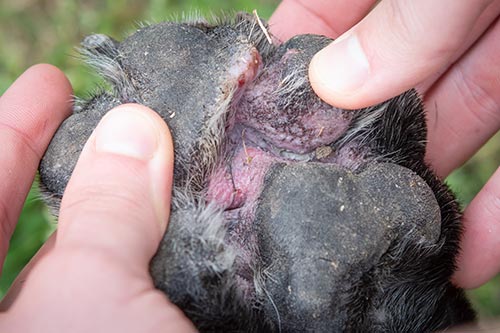
If left untreated, these symptoms can worsen over time leading to painful sores and difficulty walking. It’s essential to catch these infections early before they become more severe. Click here to view more pictures of fungal infections in dogs.
Home Remedies for Managing Paw Fungal Infections
If your pooch is dealing with a pesky paw fungal infection, don’t fret. There are home treatments you can try before going to the vet:
Antifungal Shampoo
An alternate approach to treating fungal infections is the use of antifungal shampoos or ointments available over-the-counter. Miconazole Nitrate Antifungal Shampoo is a great option that has proven to be effective in treating such infections. However, this might not be enough for moderate to severe fungal infections.
Natural Remedies
You could also consider natural remedies like apple cider vinegar soaks and coconut oil applications. These have antimicrobial properties that may help combat the fungus causing the infection. Keep in mind that, in my experience, these remedies may only offer short-term relief and not completely remove the infection.
Hygiene Practices
Proper hygiene practices are essential in preventing further spread of the infection. Washing the paws of your dog with a mild detergent and lukewarm water regularly will help keep them free from any hazardous fungi. You can also try disinfectant wipes such as these ones (Amazon link).
Clean Living Environment
Last but not least, ensure your pet’s living environment is kept clean and dry – fungi thrive in damp and dirty conditions. Check out these tips on how to clean your dog’s bed to keep their sleeping area spick and span.
Remember, if your dog’s paw infection persists or worsens, it’s always best to consult with your veterinarian.
Veterinary Treatment Options
If your pup’s paw fungal infection doesn’t clear up with the home remedies mentioned above, then it’s time to call your vet. They can prescribe stronger antifungal medications, either oral or topical, that are specifically designed for dogs. Fungal infections often require long courses of treatment so don’t be shocked if your vet recommends 1-2 month courses of antifungal medication.
As a veterinarian, I also often recommend preventive measures such as:
– regular foot hygiene and
– avoiding areas known for fungus growth (for example: damp places or public parks with poor sanitation).
Remember that each dog responds differently to treatments due to factors like breed, age, overall health status, etc. So, always follow your vet’s advice regarding treatment plans and duration of therapy.
How long will it take for a fungal infection on a dog’s paw to be cured?
The healing period may vary, depending on the intensity of the infection and any treatments employed. Typically, it may take several weeks or even months for complete healing.
To prevent fungal infections from recurring, it is important to treat the underlying cause
“Dogs can develop fungal infections in their paws due to a variety of reasons including allergies, poor nutrition or poor hygiene. Understanding these underlying causes is crucial for effective treatment and prevention.”
Let’s go through the most likely causes:
Allergies
Over 10% of dogs suffer from allergies. Allergic reactions to food, environmental factors such as pollen or dust mites, and flea bites can weaken your dog’s immune system, making them more susceptible to developing infections in their paws.
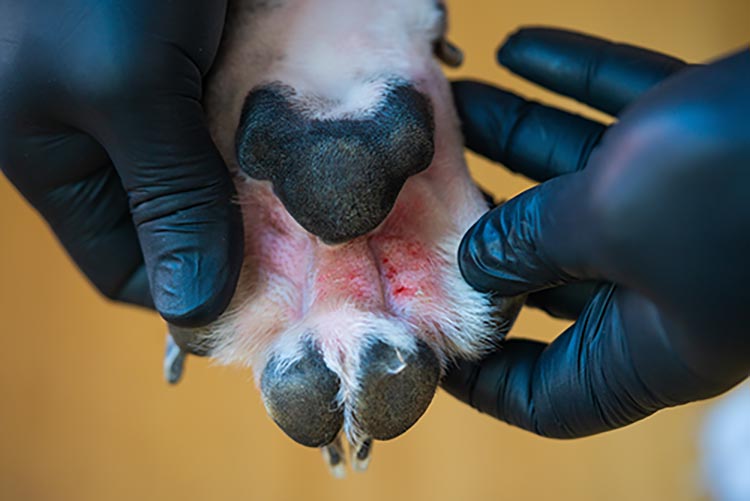
To tell if a dog has allergies, look for symptoms such as excessive itching, skin redness, ear infections, sneezing, watery eyes, and frequent licking or chewing of paws. Here is an article from the American Kennel Club that can help you identify if your dog has allergies and what treatments are available.

Poor nutrition
A poor diet lacking essential nutrients weakens the immune system of dogs, leading to skin problems like dermatitis, which increases the risk of paw fungus infection. Feeding your dog high-quality foods rich in vitamins A, C & E helps boost immunity against diseases.
Poor hygiene
Failing to keep up good hygiene practices by not cleaning your dog’s paws regularly after walks or leaving wet feet unattended creates favorable conditions for fungi growth. Here are some tips on keeping your dog’s paws clean:
- Clean your dog’s feet using warm water, then dry them thoroughly, especially between toes.
- If necessary, use anti-fungal shampoo recommended by a vet.
- Regularly trim your dog’s nails to prevent dirt and debris from getting trapped between the toes.
Hormonal conditions
Dogs with underlying hormonal conditions like Cushing’s disease, hypothyroidism, or diabetes have weakened immune systems that make them more susceptible to fungal infections.
If you suspect any of these medical conditions in your pet, it is essential to consult a veterinarian for proper diagnosis and treatment.
Diagnosis at the vet
The treatment for fungal infections is very different from other conditions, therefore accurate diagnosis is essential in getting your dog on the right treatment plan. Here is how your vet can diagnose fungal infections in your dog’s paws:
Physical Examination
First, your vet will give your dog’s paw a good once-over. They’ll inspect for any indications of inflammation, puffiness, irritation, or alteration in color. These are all common symptoms of a fungal infection. Read our veterinarian article with example pictures of fungal infections in dogs.
Diagnostic Tests
Many conditions can cause the symptoms mentioned above however, so often your vet will need to do some more tests. Your vet may use a special UV light called a wood’s lamp to inspect your dog’s paws – some species of fungi such as ringworm will glow under this light. A skin scraping test can also help identify any fungi present on the surface of your pet’s skin. In addition, a small sample of your dog’s fur can be cultured to help identify the specific fungus causing the infection.
Further Testing
If the initial tests don’t provide a clear answer, your vet may need to take a tissue sample for biopsy or histopathology. This is generally done under anaesthetic and will provide detailed information about infectious agents causing the infection.
Remember, accurate diagnosis is key to getting your pup back to their happy, healthy self. If you think your pup has a fungal infection, be sure to contact your veterinarian right away.
Frequently Asked Questions
Are dog paw fungal infections contagious to humans?
It’s rare, but some types of fungi can potentially spread from pets to people, especially in those with weakened immune systems. Good hygiene around your dog is essential – always wear gloves when handling an area on your dog affected by fungal infection.
Are dog paw fungal infections painful?
Yes, fungal infections are often painful. They can cause discomfort and distress in dogs due to symptoms like itching and swelling.
Can OTC ointments be employed to cure canine paw ailments?
While some OTC fungal creams might help alleviate symptoms temporarily and even treat mild infections, they may not effectively treat the underlying cause. Always consult a veterinarian if your dog’s fungal infection doesn’t improve or keeps coming back.
Disclaimer: This website's content is not a substitute for veterinary care. Always consult with your veterinarian for healthcare decisions. Read More.



Be the first to comment